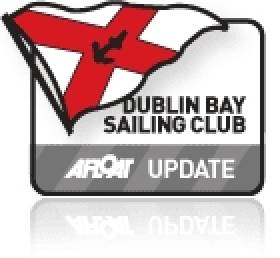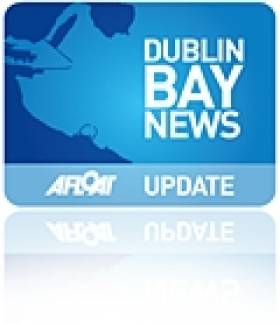Displaying items by tag: Royal Irish Yacht Club
#waterwag – Dublin Bay Sailing Club doyen Carmel Winkelmann officiated at the launch of the newest Water Wag dinghy, Mademoiselle, No. 46 on Sunday at the Royal Irish Yacht Club.
The new 12–foot clinker dinghy was built for Bay sailors Adam Winkelmann and Doug Smith. The boat was built in Skol Ar Mor, France.
The Water Wag is the oldest one design dinghy in existence, having been devised in 1886 and formalised as a one design class in Ireland in 1887. The design (last modified in 1900) is still sailed to this day on Dublin Bay and is one of the most popular dinghies sailed on the capital's waters recording some notable turnouts of late.
Immediately after the champagne launch ceremony, the Water Wag class held its annual picnic race (which has been running since 1887) with a pursuit down to Dalkey Island and back. An exciting race down to the Island with the end of the ebb tide. Mademoiselle led for most of the way but Mollie managed to overtake her coming into Dalkey sound, with David McFarland in third.
On the return home, No 1 Ethna sailed by Bill Nolan and Niamh Hooper led out of Dalkey sound, Moosmie had to go back as she was over the line but came steaming up the inside to take the win with Ethna 2nd and Mollie 3rd so taking the overall win!
The class thanks 'Thyme Out' and the Bretzel Bakery for sponsoring the fabulous lunch on Dalkey Island. Also our thanks to Brian and Anne Craig and Michael O'Leary for acting as mother ships, Dara, Caoimhe and Eddie Totterdell who had just got in from Greece at 4 in the morning from holidays and made it out drive a rib for us, also to Sandy Aplin who did a sterling job of ferrying us in an out of the Island.

Mademoiselle (above and below) led the Wags on their annual picnic race to Dalkey Island after her launch. Photos Owen McNally


The Wags moor up off Dalkey Island (above) and go ashore for a picnic Photos Owen McNally

Results;
1st Moosmie
2nd Mollie
3rd Mademoiselle
4th Ethna
5th Skee
6th Barbara
7th Coquette
8th Good Hope
9th Chloe
#sailability – On the 26th June four sailing cruisers from Lough Foyle will set off from Greencastle in Donegal on a round trip passage of Ireland stopping at each Sailability Club around the coastline of Ireland. This is to promote Sailability - sailing for disabled people in Ireland. Sailability Ireland is the new name for the Irish Disabled Sailing Association (IDSA) which was established in 1980 to introduce and encourage people of all ages with disabilities to take up sailing. Thirty years later, Sailability Ireland members are involved in all levels of the sport, from regular club racing, through international championship, to Paralympic Campaigns.
The cruisers will arrive in Dun Laoghaire for the day on Monday 29th June where they will be hosted by the Royal St George Yacht Club and Dun Laoghaire Sailability. D/L Sailability run a very successful programme of courses for disabled children throughout the Summer. 35-40 children are involved in the sailing thanks to the support of the four waterfront clubs, the Royal St. George, the National, the Royal Irish and the DMYC, as well as their instructors and volunteers.
To mark the occasion Sailability sailors from Dun Laoghaire will meet the Lough Foyle Crews for a BBQ at the Royal St. George and then head off in local cruisers at 6pm and accompany the Lough Foyle as far as Dalkey Island or perhaps Killiney Bay as they head towards the next port of call Kinsale.
Sailing for disabled people in Ireland has blossomed over the last few years and there are now centres in all provinces in Ireland. In Dun Laoghaire the programme started 6 years ago and has grown every year to the extent that all of the events this season are full, from the regular Sunday morning sailing to the week courses in June and August .
This year the Royal Irish are hosting the Presidents Cup an all-Ireland competition for disabled sailors with a team from each Province competing in 4 different types of boats. the event will be held in Dun Laoghaire harbour on 22nd and 23rd August
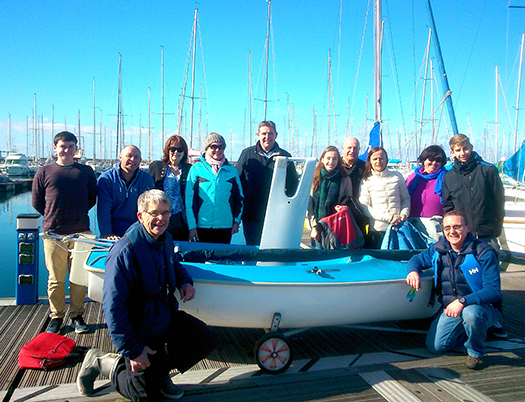
#dlharbour – Hostile questions were asked in the Dail on Wednesday by local TD Richard Boyd Barrett on the proposed development of Dun Laoghaire Harbour as a cruise liner port. They were deflected in ministerial replies about legislation currently being drafted, and the two possible viable ways forward for the harbour's administration. But the underlying pace is accelerating towards a resolution of the future of this unique example of Victorian design, engineering and construction. W M Nixon finds that, in recent days and weeks, his views on the possible uses of this magnificent artificial harbour have undergone considerable change.
Embarrassment is a powerful stimulant for change. Change of attitude, change in ways in behaving, change in ways of looking at things, change to entrenched ways of thinking. I was hugely embarrassed by something seen in Dun Laoghaire nine days ago. And within seconds, there came a complete epiphany, with the sudden awareness that an entrenched attitude towards the development of Dun Laoghaire as a cruise liner port had turned through about 140 degrees.
It made for the complete 180 degrees, as the first 40 degrees of the turn had already been achieved a couple of weeks previously, while spending two completely absorbing if mentally exhausting hours with the maverick Alistair Rumball and his team at the Irish National Sailing School beside the inner recesses of Dun Laoghaire's inner harbour, which is still called the Coal Harbour even though it's very many years since anyone offloaded any lumps of the black gold there.
Be that as it may, as we parted we were shooting the breeze about the proposed development of Dun Laoghaire as a cruise liner port, which has been top of the local agenda since the end of March, and handily gave us one of our choicer April Fool's Day stories here on Afloat.ie - it proved so effective we had to add a health warning.
When a story provides you with something like that, you develop a certain affection for it. So while Alistair and I agreed that that the absolute dream solution for Dun Laoghaire Harbour would be a top-of-the-line government-funded National Monument Preservation Scheme, with the entire place given over exclusively to recreation afloat and ashore, and no commercial shipping of any significant size whatsoever allowed about the place, we knew it was pie in the sky.
"How on earth would they really pay for it?" he asked. "This place is huge, it costs a fortune to run and maintain. A cruise liner berth offers the best and most compact method of providing a worthwhile income stream. And as we in our sailing school – being a commercial operation – have to be rigorous in observing harbour regulations and keeping clear of the established in-harbour shipping lanes, we know that you can continue to sail small boats in large areas of the harbour without any undue sense of space restrictions".
Subsequently, I've been spending some time around Cork Harbour, where circumstances are so different from Dublin Bay that, unlikely as it may seem, you end up feeling sorry for the sailors of south Dublin. For while Cork is almost embarrassed by its riches in natural amenities for sailing, and it's all in a large and attractive harbour where marinas can be put down almost anywhere with no more than a floating breakwater to provide the necessary minimum of shelter, Dublin Bay by contrast is a hugely deprived area in terms of natural waterfront facilities for sailing, yet any attempts to provide man-made shoreline amenities for boats and sailors are dogged with local opposition every inch of the way.

Around Cork Harbour, it only needs a floating breakwater and, hey presto, you've suddenly got a marina - as seen here at Monkstown. Photo: W M Nixon
Thoughts of this struggle, and how things change, emerged again for various reasons in Dun Laoghaire nine days ago, at the reception in Irish Lights HQ to launch the Great Lighthouses Tourism Initiative. Time was when our many fine lighthouses were places of mystery, and permission to visit took quite a bit of arranging if it could be managed at all. But my word, times have changed. In this electronic age, there are those who wonder if we need all our lighthouses. Yet Irish Lights is legally obliged to maintain them, and the built structures around them.
So Yvonne Shields, the CEO of Irish Lights, whom we'd describe as very switched on and extremely bright were we not talking of the top executive in a lights organisation, unveiled this sensible scheme whereby twelve of our greatest lighthouses are being transformed into stations on a tourist trail, while continuing as working lighthouses.
As the greatest and most monumental lighthouses on land tend to be on rugged headlands in remote areas, in the eyes of Brussels they're in peripheral areas deserving special aid. So there's €2 million of Eurodosh going into this project, which sees what had become increasing liabilities being transformed into tourist resources. And if we're going to be sniffy about that, let's face it: the kind of tourist who'll want to visit a remote lighthouse will not be the kind of tourist who would keep you well clear of Temple Bar.
So the old grey matter was churning briskly away on the business of seeing lighthouses in a new way as we headed home past the Coal Harbour, and there it was: The Embarrassment. For this was the evening at the end of the day when the majestic and rather handsome cruise liner Queen Mary 2 was anchored off Dun Laoghaire in a near gale from the southwest which had delayed the morning's arrangements to ferry passengers ashore in the ship's own tenders to the special landing pontoon installed by the Harbour Company in the inner harbour.
By this time, they were trying to return on board, waiting patiently in a queue which ran the length of the inner pier and more as the two ship's tenders bustled the mile and a half plus out to the ship, yet still more buses turned up to disgorge more passengers, such that for a while the long length of the queue seemed to stay persistently the same.
Perhaps it's because we Irish don't do queuing that I found the entire thing acutely embarrassing to behold. And it wasn't even as if it was raining, which it well could have been. Nevertheless it struck me as being a Third World sort of scenario. Yet obviously these people were keen to visit Dun Laoghaire – most of the thousands of passengers on board had elected to go ashore.

This just won't do at all – images of Third World destinations came to mind on seeing the passengers from the Queen Mary 3 queuing in the Coal Harbour in Dun Laoghaire to get back out to their ship anchored in the bay. Photo: W M Nixon
So the epiphany came with the essential flashing great light. If we're going to have cruise liners calling at Dun Laoghaire, boomed this disembodied voice, then let's do it properly and provide them with a proper berth. Otherwise, don't have them about the place at all. But please, please – no more buzzing in and out in little tenders in this Irish climate, and no more queuing on a comfortless pier. It's an affront to our best traditions of hospitality.
This sudden firing-up with all the zeal of the recent convert (for until then, I'd wanted Dun Laoghaire to stay exactly as it is, and damn the expense) resulted in my being right into the dragon's den four days later. It was meant to be a short and businesslike meeting with Gerry Dunne, the CEO of Dun Laoghaire Harbour Company, to discuss the Cruise Liner Berth Proposals. But so many ideas were flying around that we ran well over time.
Please be assured, though, that I did my best to represent the needs of the boat-owning and sailing community while accepting that since Stena Sealink withdrew from running a ferry service from Dun Laoghaire to Holyhead, something very serious indeed needs to be done to pay for the maintenance of the harbour.
We have to remember that, among Ireland's main sailing centres, Cork and Kinsale are blessed with such good natural harbours that any marinas located in either harbour do not need fixed breakwaters. As for Bangor Marina on Belfast Lough, it may need a very substantial solid breakwater on its north side, but otherwise - thanks to being located in a bay - three of its four sides are naturally sheltered. But Dun Laoghaire is badly done by – it's so totally an artificial harbour in an exposed location that three of its four sides are protected by large man-made breakwaters, and while they are constructed in monumental style, continuous monitoring and maintenance is essential.
This is costly, but it would become even more so were standards allowed to slip for even a year or two. Even with the present high standards, there can be underlying wear and tear which in time needs major capital expenditure, and according to one recent report, hidden erosion on the most exposed section of the East Pier may eventually need up to €5 million for a proper remedial job.
As it is, the current basic running costs of the harbour are between €2 and €2.5 million a year. Were it kept as a purely recreational harbour and general public amenity, this figure could perhaps be slightly reduced. Yet the Dun Laoghaire recreational boating market still could not withstand paying the full amount out of its own resources and expected annual expenditure, so the shortfall would have to be made up by Government subvention.
But would the sailing and boating people of Dun Laoghaire really like to feel that they're beholden to taxpayers throughout Ireland for their continuing enjoyment of this wonderful amenity at affordable prices? There's something unpleasantly artificial about the idea of such an arrangement, whereas a harbour which is providing a modest but genuine profit is something which has a much healthier feel to it.
Surely if a way can be found of generating a worthwhile income stream without unduly distorting the traditional functioning of the harbour, then that idea should at the very least be actively explored, and recreational boating groups should be prepared to reach out towards compromises in the knowledge that, in turn, such arrangements would make the Harbour Company more accountable to all.
However, local representative Richard Boyd Barrett TD of the People Before Profit party, and Chair of Dun Laoghaire Save Our Seafront Group, sees it differently, and he has called for "a major campaign of people power against the planned cruise berth, and to protect the future of the harbour as a public amenity". His three main objections to a cruise berth plan are "(1) That the cost and financing of the project at €18 million means that the Harbour Company will have to borrow using its existing assets, where no proper business case has been produced. This puts the very future of the harbour at risk. (2) The entire plan has been hatched by an unelected board of the Harbour Company, Council Executives, and local business people who ran a sham of a public consultation over the two weeks of the Easter Holidays, and (3) The scale of the luxury liners at 300 metres long and 59 metres high will dwarf the harbour and reduce public access and public enjoyment of the most intact Victorian harbour in Britain and Ireland".
So with a Harbour Company which is government-owned, yet is charged with maximizing the economic benefit and exploiting the commercial opportunities provided by Dun Laoghaire Harbour, clearly there is something of a divide between the two sides. In fact, "light years apart" just about sums it up.
Nevertheless, politics being the art of the possible, it has to be possible to bring people together sufficiently to see that perhaps a proper sympathetically-designed cruise liner berth might indeed be the answer. After all, although it was built between 1817 and 1842 purely as a harbour of refuge for sailing ships with no thought of any interaction between sea and land, it very quickly became a ferry port for cross-channel steamships. At the height of this activity, with frequent roll-on roll-off ferries and their unpleasant shoreside traffic dominating the waterfront, Dun Laoghaire had lost much of its charm.
For the life of me I can't see that the much more limited shoreside traffic generated by the visits of cruise liners in the summer months can be seen as being anything like as obnoxious as the previous waves of road and rail traffic for the ferries, which was readily tolerated, and helped to keep the place going for 180 years.
And in any case, with the end of the ferry services, Dun Laoghaire definitely lacks purpose. In the Irish climate, it is very difficult to maintain a sense of vitality around a harbour which is purely devoted to personal recreation, whether afloat and ashore. It could be argued that, regardless of the economic benefits, it would be good for the mental spirit and communal well-being of Dun Laoghaire to be a cruise liner port of call, as a cruise liner strikes a neat balance between work and play. Like it or not, all work and no play may make Jack a dull boy, but all play and no work makes him mad.
But even if we accept that the shoreside traffic will be much less than it was with the regular ferries even if there is a cruise liner in port every other day, that is only part of the equation. How does the town itself shape up as a desirable cruise liner destination?
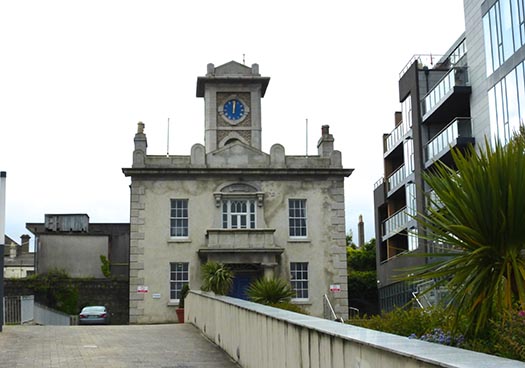
The Harbour Lodge is symbolic of today's Dun Laoghaire, a classical building from an earlier age, but now enclosed by modernity. Photo: W M Nixon
When we get down to the nitty gritty like this, Gerry Dunne is in his element. He's an affable guy, and good company, but I wouldn't like to get into a row with him, as there's steel underneath it all. So in the sedate setting of Harbour Lodge – which he cheerfully admits his opponents and friends have nick-named "Mussolini's Palace" – he's just the man to fight off the brickbats and work his way towards several objectives. But although he actually lives in Dun Laoghaire within walking distance of his office, he's not really into boat and water sports, yet that's no drawback, as personal preferences definitely don't come into it at all as he plans the way ahead.
He makes no bones about admitting that his attitude is strongly commercial. Before taking over the reins at Dun Laoghaire Harbour Company, he was Commercial Director at RTE, a job description which boggles the mind. Before that, he honed his skills in the UK, working for several large Irish food companies. If that gives you a vision of ditzy little artisan cheeses selling in agreeable country shops, then perish the thought – the big Irish food industries provide as tough a business environment as you could imagine.

The many moods of Gerry Dunne.Toughened by a varied and demanding career in business and marketing, he has brought a fresh mind to the problems of making Dun Laoghaire harbour economically viable. Photos: W M Nixon
He joined the Harbour Company in 2009, when talk of Stena's withdrawal was already in the wind. So he got Dun Laoghaire moving towards the cruise liner market in a small way, with the miniature 53-passenger Quest in 2011. Finding Quest an in-harbour berth was no problem, and she provided invaluable information on what Dun Laoghaire can provide as a USP for discerning cruise liner passengers. For Quest's rather specialist group, it was the easy access to the Wicklow Hills and particularly Mount Ussher Gardens, and they definitely didn't want to have to travel through Dublin City to get there.

The mini liner Quest – seen here in the Arctic - began the programme of attracting cruise ships to Dun Laoghaire in 2011
So far so good, but Gerry Dunne really struck gold when he started going to the cruise liner fairs in America and Europe. Gradually he built up a useful network, and again he struck gold when he got a report on the potential attractions of Dun Laoghaire from the Vice President (Itineraries) of one of the biggest American cruise liner conglomerates. Asked to sum up in one word the attraction of the Dun Laoghaire for visitors coming in from sea, her answer was: "Serenity".
We've become accustomed to Venice being talked of as The Most Serene Republic - The Serenissima. But it makes you sit up and take notice to hear of Dun Laoghaire being so described by a tough American businesswoman. Yet that's the impression the waterfront area, with its combination of the old yacht clubs, the station, the Town Hall and the Royal Marine Hotel, apparently makes on seaborn visitors from cruise liners, even if their liners are at present anchored outside the harbour and they have to be ferried in to land by ship's tenders. It seems they can blank out the less attractive buildings, and are left with the abiding impression of relaxed elegance with an easygoing way of life.
This takes a bit of getting used to, as it's so much at variance with the perception in Ireland of Dun Laoghaire as a place where they'd argue over anything and everything all the time, while just up the street there's the real problem of the dreary array of boarded-up shops. But like it or lump it, here it is folks – the reality is the yacht clubs and other other historically significant and stylish buildings of the Dun Laoghaire waterfront area – including the pleasantly under-stated Victorian residential terraces - are the town's greatest tourist asset.
Quite what some of the more senior members of the yacht clubs will make of that we can only guess, but the word is that the clubs have indicated that they'll be prepared to welcome some cruiser liner guests to their premises at pre-arranged times. So perhaps we should see the cruise liners as no more than extra-super super yachts......And there's no doubt that many rugged sailing folk from Dun Laoghaire are themselves only too happy to tootle off on a cruise liner when the peak of the sailing season is over.
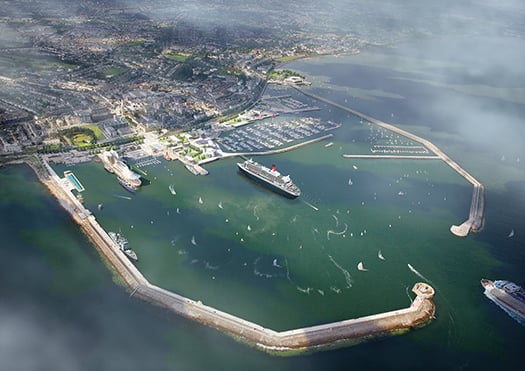
The artist's impression was just that – an artist's impression. If the new berth goes ahead, cruise liners will actually have their sterns towards the town.
But what is the reality if the new berth is agreed? Well, you can forget about your artist's impressions showing a liner facing the town. Space will be restricted, so the liners will come in stern first, thereby enabling them to make an elegant departure for the benefit of crowds down the end of the piers, which could become a popular occurrence.
The new liner pier will be as short as possible, though it will have an underpass for small craft, while the bows of the ships themselves will be held in place by dolphins, as was the HSS ferry. If you think that getting into this berth will involve impossibly ticklish manoeuvring, consider this recent photo of the three Cunard Queens up close and friendly in Southampton, and note that there's no lack of small craft nipping about among them.
 The three Cunarders can manoeuvre unaided at close quarters even with several small craft nipping about their heels, as seen here in Southampton
The three Cunarders can manoeuvre unaided at close quarters even with several small craft nipping about their heels, as seen here in Southampton
One of the other drawbacks about the current setup, with the ships anchoring off and people disembarking in the Coal Harbour, is that there's very little space for buses to move about, but the present waterfront marshalling yard left behind by the exit of Sealink will greatly relieve that problem if the new berth is built. At the moment, it is planned that passengers will walk the short length of the pier to reach their buses, but my own feeling is that the pier should be made a bit wider with a turning circle in order that passengers may board their buses almost directly from the ship, for we're not talking long distance athletes here.
That said, those who are fitter can come and go as they please, with the town within easy reach, whereas being anchored off can cause cabin fever. In other words, if Dun Laoghaire is going to have a cruise liner berth, let it be done properly – half measures involving long walks to buses just won't do, but equally for those who do walk, the town must feel accessible and welcoming.
As to the amount of space the ship will take up in the harbour, that will vary from ship to ship, but some are indeed enormous. And their wind-deflecting presence will certainly add an extra interest to in-harbour dinghy racing. As for the interest of the in-harbour racing for the visitors on the ship, that in turn will all be part of Dun Laoghaire's colourful charm, for which their ship will provide a grandstand view.
In line with that, we should remember that the leading in-harbour class, the historic Water Wags, have only just returned from showing themselves off at Morbihan Sailing week in France. Thus they'll scarcely be unduly bothered about providing a source of fascination for passengers on cruise liners, some of whom will probably be former dinghy racers themselves.

The Water Wags find it easy to sail freely within Dun Laoghaire Marina on their way out to race in the main harbour, so their only problem with a cruise liner berthed in mid-harbour will be the effect it has on wind flow. Photo: W M Nixon
But what the in-harbour dinghy racers are already becoming happily accustomed to is the newly-emptied eastern half of the harbour, with space now provided where boats used to moor. And this area will not be at risk from maneuvering cruise liners – there's not the depth for them. Finally, as to the height or otherwise of the ships in relation to other structures in Dun Laoghaire, I think we've been righteously indignant about this on a mistaken premise – since the new library was pushed into place, all bets about skyline heights and an elegant relationship with other waterfront buildings are clearly off.
So if the sailing and boating community can be more accepting of the cruise liners which will ultimately provide a real source of income to maintain the harbour which makes their activities possible, what can they expect in return?
They're in a strong negotiating position. After all, the Harbour Company's research has shown it is the comfortable presence of the yacht clubs which underpins this vision of serenity which is Dun Laoghaire's most appealing attraction for the kind of people who enjoy the cruise liner experience. So it's very much in the Harbour Company's interest to keep the clubs in good health.
By today's standards, the Royal Irish YC is thriving, thanks in no small part to its location within the marina against whose creation, ironically, the club fought tooth and nail. But the other three clubs – the Royal St George, the National, and the Dun Laoghaire MYC – are blighted by the limited and relatively unsheltered pontoon berthing at their clubhouses.
It may well be – and I'm only guessing – that the Marina Company's agreement with the Harbour Company includes a clause that these three clubs are not allowed to have their own adjacent marinas. But if such a clause exists, then it should be deleted for the greater good of the harbour and the vitality of the waterfront in general, and the three clubs should be facilitated in providing 150-boat marinas – with proper breakwaters for the George and National - in front of each clubhouse.

Dun Laoghaire from the southeast. If the new cruise liner berth is installed at mid-harbour, a longterm plan could be the installation of breakwaters in front of the Royal St George YC and the National YC in the foreground to shelter two new 150-boat marinas, as the location of the Royal Irish YC within the main marina gives it an unfair advantage in providing facilities for its members.
As to how Dun Laoghaire town can benefit, that's another matter altogether. The much stronger income and improved employment going through the Harbour Company will undoubtedly be a tangible good, though how seasonal it will be – with liners expected only between April and October – remains to be seen.
But personal expenditure by cruise liner passengers in the town is an imponderable. In fact, some cruise liners in the popular sunshine destinations are notorious for disembarking guests who feel that they made their total investment with the purchase of the ticket back home, so they don't plan to spend any more.
The historic little Venetian city-port of Dubrovnik on the Adriatic – which doesn't have a proper liner port – recently banned cruise liners from coming anywhere near the place, as their thousands of passengers made the narrow streets very uncomfortably crammed at peak times, yet the average expenditure ashore in Dubrovnik by each cruise liner passenger was precisely €6. There's food for thought. But we will of course get a better class of cruise liner passenger in Dun Laoghaire...
#sb20 – Jerry Dowling's Bad Kilcullen from the Royal Irish Yacht Club emerged the winner of a breezy 17–boat Leinster Championships off Dun Laoghaire at the weekend by a two point margin. Second was Cork based Corona Extra with Howth's Dinghy Supplies third. Full results for the Royal St. George Yacht Club hosted event are downloadable below. The event was sponsored by O'Connor Intellectual Property.
The fleet were delighted to welcome back SB20 stalwarts Peter Kennedy, Dave Cheyne and Stephen Kane on Ridgefence, Colin Galavan helming Bad Kilcullen (on Saturday), Rick Morris crewing on Ruby Blue and Marco Sorgassi and his new crew on Lupi d'Irlanda. The fleet were also delighted to welcome new young guns Tim O'Laoire, George Kenefic, Rob Bearla and Aoife English on SacreBleu. After some years of steady numbers, the fleet is once again showing promising signs of growth with several boats changing hands in the last few months and it was encouraging to see the returning stalwarts and new converts competing at the sharp end of the fleet.
17 boats took to the start line on Saturday in a fresh to strong westerly wind. With the gusts topping off at 28knts in a short chop, conditions were perfect to showcase SB20 racing at its very best and the fleet certainly didn't disappoint. OOD Barry O'Neill and his team had their work cut out for them with the westerly breeze shifting through 50 degrees throughout the course of the day but they did an exceptional job providing three excellent races on Saturday in such testing conditions.
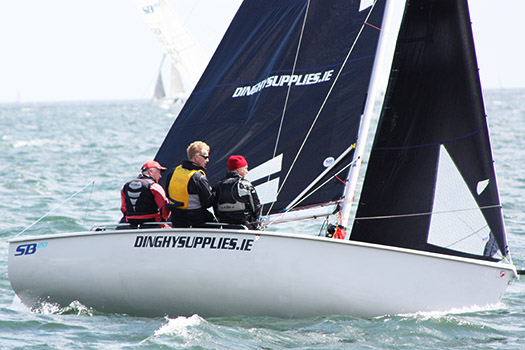
Race 1 saw Davy Taylor, Marty O'Leary and Rachel Willamson on Yachtsman.ie take an early jump on the fleet closely pursued by Dinghy Supplies (Daragh Sheridan, Shane Murphy and John Phelan), Ruby Blue (Aidan O'Connell, Rick Morris and Johnny Horgan) and Sin Bin (Michael O'Connor, Owen Laverty and Kevin Johnson). With the wind shifting about and gusting so frequently, there were plenty of passing opportunities and in the end Sin Bin snuck into the lead to finish ahead of Dinghy Supplies with Ruby Blue in third and Corona Extra (Graeme Grant, Ronan Downing and Breffni Jones) recovering well to finish in fourth. Race 2 again saw the fleet tussling for position but by the second weather mark Ruby Blue had built up a commanding lead over the chasing pack of Sin Bin, Ridgefence, Yachtsman.ie and Bad Kilcullen (Colin Galanvan, Gerry Dowling and Jimmy Dowling). Tragedy struck Ruby Blue as they snagged the weather mark anchor line on their way to what surely would have been an unassailable lead down the final run. Second around Sin Bin were unable to take full advantage as they broached three quarters way down the run putting an end to their hopes of race victory. The crew of Yachtsman.ie showed sublime boat handling skills to keep the boat under the rig and took a well deserved victory from Dinghy Supplies in second, Corona Extra in third followed by Bad Kilcullen in fourth. Ridgefence were getting into the swing of things with a creditable fifth. In Race 3, Ruby Blue again got off to a flyer but this time there was to be no repeat of their error in Race 2 and they won convincingly from a chasing pack of Bad in second, Corona Extra in third, Dinghy Supplies in fourth and Ridgefence once more in fifth.
At the end of day one, Dinghy Supplies were leading on 8 points (2,2,4) from Corona Extra (4,3,3) and Yachtsman.ie (6, 1, 7) in third however a protest between Corona Extra and Yachtsman.ie saw Yachtsman disqualified from race 1 and relegated down the leaderboard. Venuesworld (Ger Dempsey, Chris Nolan and Rory Groves) were promoted to fifth in race 1. The exhausted but very happy crews convened to the bar of the Royal St. George for some well-earned apres sail pints followed by a magnificent meal in the club room of the George. There were plenty of tales of high speed escapades with many recording speeds in the high teens on the downwind sleigh-rides. SacreBleu reported a speed of 22.6 knts which was put down by everyone else to a malfunctioning speedo until we saw the photographic evidence and eye-witness reports from the committee boat of a blue blur passing them by very, very quickly!
Sunday dawned with a slightly, although not significantly, lighter breeze (F4 gusting F6 at times) and the competitors ventured out onto Dublin Bay once more in the expectation of more thrills and spills. Race 4 saw new boat to the fleet Bango (James Gorman, Philip Lawton and Keith Staunton) showing some impressive upwind speed to lead at mark one but they were unlucky to be swallowed up by the chasing pack who caught the gusts fractionally earlier on the downwind leg. By the end of race 4, Ruby Blue was back to the fore showing impressive speed and tactics to take their second race win of the series, giving them a (3,1,1) to count with the discard coming in. They were followed by Bad Kilcullen in second (now with regular helm Stefan Hyde in place of super sub Colin Galavan), Corona Extra in third continuing to put in a very consistent series, new boys (and girl) SacreBleu in fourth and Lia (Dave Barry, John Malone and Ger Bythell) in fifth. In Race 5, Ridgefence were fully into the swing of things and won from SacreBleu in a commendable second place followed by Corona Extra in their now customery third place, Bad Kilcullen in fourth and Yachtsman in fifth.
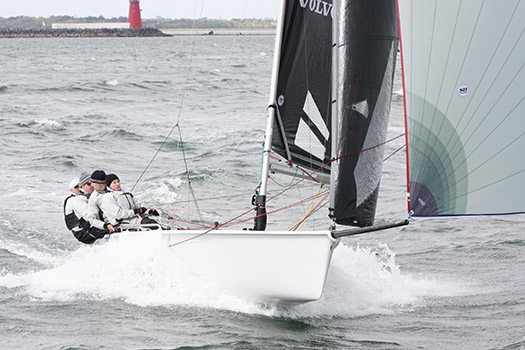
After five races, things were very close at the top with Bad and Corona Extra tied on 12 points followed by Ruby Blue on 14 points, Dinghy Supplies a further two points back on 16 points and Ridgefence on 17 points not entirely out of the reckoning. In Race 6, Sin Bin led at mark 1 and were being followed closely by Dinghy Supplies, Bad Kilcullen and Corona Extra. These boats tussled it out over the following legs with the three lead boats overlapped going into the final gate! In the end, Sin Bin took the race win, their second of the championship, from Bad in second and Dinghy Supplies in third. Corona Extra took fourth and Venuesworld.com showed a return to form with a fifth in the final race of the day. At the end of the series, Bad Kilcullen were worthy winners of the 2015 SB20 Leinster Championship with Corona Extra in second, Dinghy Supplies in third, Ruby Blue in fourth and Ridgefence in fifth. The silver fleet was won by SacreBleu who came in eighth overall. Interestingly, none of the top three boats managed a race win showing that in this fleet, mistakes are severly punished and there is a high standard throughout with anyone capable of winning a race. Prizes were awarded to the competitors by new RStGYC commodore Justin McKenna and the Royal St. George Yacht Club and race committee were highly praised by the competitors at the prizegiving for a thoroughly enjoyable event. Next up is the Southern Championships in RCYC in early June where another good turnout is expected.
#rssailing – To the untrained eye it was business as usual for the RS400 class racing out of the Royal Irish Yacht Club in Dun Laoghaire over the weekend. We had a big and very competitive fleet of 25 RS400's add to this the sight of new sails pouring out of the McCready's sailboats van on the first morning and the scene was set. The expectation of great racing, and a forecast for good wind and sun had everyone excited.
Overall results sheets for each fleet are downloadable below as pdf files.
The fleet's current top names are all well-established now. But look down the fleet at the new names and the general quality of the field and you will know that this event and this season is something special in Irish Sailing. Nobody in the top 12 was a rookie this year and Sean Cleary, defending Eastern Champion and runner up at the Sothern's and for the overall traveler's series last season was to finish up 12th. He was sailing with a new team mate Donal Murphy who had helped him to second RS400 in the local frostbites a few weeks earlier. Sean heads to England for a new job now and he will be sorely missed at Irish regionals. We look forward to following his progress, no doubt at the front of the UK 400 scene. He is expected to re-appear at the Irish Nationals later in the season.
New class member and Ex-helmsman's champ George Kenefick finished 16th overall. He will no-doubt be more competitive as the season progresses, and expressed some frustration at his form, he is one to watch over the season. Ex-Mirror world runner up and Ex-Mirror National Champion Andrew Woodward and crew Michael Walsh on their first outing with fresh sails came in 13th. Of course this is just one event and high quality sailors like Andrew, Sean and George will always find a way to excel in a class, but there is a feeling now in this class that anyone can be outside the top 10 in any race. A notable statistic looking at the results is that only three sailors managed to have all six race results inside the top ten over the Eastern championship weekend.
Now let's talk the business end of the fleet. Coming into this regatta, Alex Barry and Richie Leonard of MBSC/RCYC had been pushed hard for all of the 2014 season, but were an unbeaten pairing in the Irish events they attended together and had taken the travelers title, and Nationals. Gareth Flannigan and David Fletcher were of a pedigree that had them likely to compete for top honours, with a history of winning national titles in a variety of classes including the Laser and SB20. Local RStGYC team and Ex RS400 national champion paring of Emmet Ryan and his brother James were together again for their first regional since the 2013 season (James had been on a year of travel).
The Ryan team had been tuning up in the frostbites and it showed, with a great recovery from an average start line position and an opening race win to set their stall out early. They would be competitive to the end, and had they won the last race would have been champions. In the end the Ryan's had to make do with a couple or race wins that contributed to their 3rd place overall. James will be proud of the fact that he clearly has not lost his competitive edge on his travels.
Gareth Flannigan showed why he has about six nicknames mainly describing him as some sort of fish in water as he and David Fletcher had pace to burn upwind and were extremely consistent all event off the start line. Like Ryan he recorded two bullets, but he also managed to keep his other scores in the top 5 and had the sort of regatta dreams are made of.
Alex Barry and Richie Leonard were not going to be easy to beat, and showing their class, after a string of top 3 finishes, the top Irish pairing fought off David Rose and Ian Hef on the last run of the last race to record a bullet and do enough it would seem to take the regatta. As it turned out, a boat that had been disqualified for being OCS on day one had been reinstated (It felt from where I was sitting that a few boats were over on that start) and Alex and Richie were to be denied due to this points change and only by the a countback, having matched Gareth and David's 11 point tally.
This fleet is super competitive and there were just six points separating the 3rd placed Ryan team on 20 points with 5th and 6th placed teams Chirs Penny (Artemis-Racing) and Simon Martin, and David Rose and Ian Hef on 26. Ross McDonald and Dylan Gannon finished 4th just two points behind Ryan on 22, after an excellent regatta. Ross is an Ex-Laser National Champion. So congratulations to Gareth and David sailing out of BYC who are well deserved 2015 RS400 Eastern Champions. Excitement is already building for the Northern champs up next in the regional calendar. Remember for those in the fleet looking to sharpen up their skills, there is a sprint regatta out of the Royal St George Yacht Club on May 9th, for RS200's and RS400's.

RS Fevas
Sixteen Feva teams turned out to compete for the Eastern title this year. This is an exciting year with a trip to the worlds coming up later in the season. The fleet included two visiting teams from Galway (GBSC), and both fared very well in the event with a fourth for Aaron O'Reilly and David Carberry and a seventh for Brian Murphy and David O'Reilly. Great to see Feva's that are willing to travel and make this class really exciting.
The top three places were all local Dublin bay RSGYC sailors. Triona Hickson and Kathy Kelly won the first two races of the event and finishing just 3 points off the lead in third place could easily have been champions.
Toby Hudson-Fowler and Greg Arrowsmith had an excellent regatta and would finished second on 10 points, just one point behind Tom and Henry Higgins, who took the championship in the last race.
Congratulations to Tom and Henry Higgins who are RSFeva Eastern Champions for 2015.
RS200s
There were many very well attended events last season in Ireland. This season is an exciting one for the RS200's particularly as the fleet welcomes a revamped sail plan that modernizes the boats look and feel.
The turnout for this event was effected by exam season for the younger members of the class, so expect bigger fleets as the season progresses.
The top end of this fleet looked very familiar, as Marty O'Leary and Rachel Williamson sailing out of RSGYC continues to dominate the RS200 Class in Ireland with a performance including three bullets, two seconds and a third. Marty and Rachel had showed their class before the event, finishing runner up to the Ryans RS400 team in the frostbites.
They were matched this time on points by the every present Ex National champion Sean Craig and Heather King, who would only be second on countback having matched Marty and Rachel this time also on a final point's tally of 7. Frank O'Rourke and Sarah Byrne were eight points back in third, and Luke Murphy and Patrick Cahill had some great moments and finished fourth overall. Luke and Patrick are strong prospects for the future and sail out of RSGYC. Congratulations to Marty and Rachel who are RS200 Eastern Champions for 2015.
#dlregatta – In a first for Dun Laoghaire Regatta the first C&C30 design in Europe will compete for the overall title at Ireland's biggest regatta this July.
After dominating their class and being crowned top overall boat at the 2013 Dun Laoghaire Regatta, Checkmate Sailing from the Royal Irish Yacht Club are returning to Dublin Bay to defend the title. Their all conquering Humphreys Half Tonner has been replaced with Checkmate XVI, a new C&C30 from the drawing board of Wicklow based designer Mark Mills.
Skipper Nigel Biggs says "Dun Laoghaire Regatta has always been one of our favourite regattas. We have competed here for many years and having been honoured with the top boat award last time, we were determined to come back and try to retain this prestigious award.
During our last project with Checkmate XV we were fortunate to work with Mark Mills who was instrumental in turning a near 30–year–old IOR racer into a competitive IRC boat. Having sold Checkmate XV to our good friend Dave Cullen we were looking for a successor and Mark suggested the new C&C 30 that he had designed.
The boat ticked every box for us, sailed by a relatively small crew, extremely fast, trailable and with the prospect of competitive one-design racing. Checkmate XVI is the first of the class in Europe and although she has only recently arrived from the US we are already finding her extremely rewarding to sail. We are very much looking forward to bringing her to Dun Laoghaire Regatta and catching up with all our friends again
Biggs says 'we have always been made to feel incredibly welcome at this event and feel it strikes the perfect balance between competitive racing and fun socialising. I am extremely privileged to have recently been elected as a member of the Royal Irish Yacht Club and am looking forward to racing under their burgee this year'.
The C&C 30 One Design and offshore-capability and fast sailing performance at an affordable price has picked up the 2015 American SAIL MAGAZINE Best Boat award. See vid below.
{youtube}Vb2na2iwvn8{/youtube}
Promoter C&C in the USA hopes to develop the boat into a high-performance, offshore-capable one-design class that's both easy to sail and affordable compared to other grand prix boats.
The C&C 30 is loaded with go-fast goodies including a centerline sprit pole, a double-spreader carbon-fiber rig, an open transom, an offset companionway, a flush deck, plumb bow, halyard locks (main and jib) and an expansive cockpit.
The C&C 30 is being built in Bristol, Rhode Island.
#vdlr –With an entry list the envy of regatta organisers everywhere, July's Volvo Dun Laoghaire Regatta (VDLR) has received a massive entry of 302 boats so far with three months to run to its first gun. Over 63 different yacht clubs are represented in a fleet that will split into 20 different sailing classes for the four day extravaganza at the Irish east coast port. Enthusiastic insiders say the tenth anniversary of the event may yet hit its all time high of 500 boats by July 9 but a more modest reckoning of 400 plus will certainly match the 2013 and 2011 editions of Ireland's largest sailing event.
Run by the four waterfront clubs of the DMYC, RIYC, NYC and RSt.GYC's this year's event is under the stewardship of former Fastnet race winner Tim Goodbody and Dragon Edinburgh Cup winner Martin Byrne. An overview of the biennial event was published by Afloat.ie last weekend in WM Nixon's blog here.
The bulk of entries come from the Dublin Bay area itself but there is also strong interest from along the east coast from Greystones, Arklow, Howth and Skerries. Most encouragingly, the event is proving to be a draw for boats from further afield too with entries from across the Irish Sea some of the first to sign up.
As previoulsy reported by Afloat.ie, the following events are confirmed as part of the event:
Royal Dee Yacht Club Irish Sea Offshore Championship
J109 Irish National Championship
RS Elite Irish National Championship
Beneteau First 21 Irish Championship
Wayfarer Irish National Championship
GP 14 Leinster Championship
J24 Leinster Championship
In encouraging news for dinghy sailing (that has separately been given a shot in the arm this year by local DBSC organisers), it looks like VDLR will also see a lift for centreboard classes. 2015 will see a record number of dinghies classes participating. In addition to the regular one designs such as the Mermaid, Flying 15, Squib, Fireball, IDRA 14 – organisers are welcoming the GP14, Wayfarer, RS200/RS400, Laser classes to the regatta with their own starts.
It is the first visit to the Regatta for the GP14 fleet and organisers are very much looking forward to welcoming the class, all of whom will be from visiting clubs from around the country. An expected entry of 40 GP14's are expected and they will be hosting their Leinster Championships as part of the Regatta.
The Wayfarers are returning after running their a successful UK Nationals within the 2011 Regatta and this year they will be running their Irish Nationals, an expected entry of 20 visiting Wayfarers are expected.
Big entries are also expected from both the Laser and RS fleets. It still remians to be seen if the PY class can muster sufficient numbers.
VDLR had issues recently with its online payment. To accommodate anyone who has had difficulties it has extended the early bird discounted entry fee offer deadline to Friday, April 17th.
Olympic Race Officer To Explain How To Run Yacht Races
#yachtracecourse – Olympic Race Officer Jack Roy is giving a course this Wednesday in the Royal Irish Yacht Club, Dun Laoghaire for all those who want to run races or help on committee boats in any capacity.
The course is also suitable for sailors seeking a better understanding of the racing rules surrounding race organisation and course laying.
With a number of high profile events coming up in 2015, including the Volvo Dun Laoghaire Regatta and the Dublin Bay Sailing Club schedule, Dun Laoghaire will be looking for more volunteers this summer! The cost is €10 (to cover soup and sandwiches). For more click here.
Royal Irish Yacht Club Get Behind Women's 49erfx Olympic Bid
#49erfx – Saskia Tidey and Andrea Brewster's Olympic skiff campaign has been boosted by support from Club commodore James Horan of the Royal Irish Yacht Club.
The RIYC duo are currently seeking Olympic selection in the 49er FX Skiff Class for the Rio de Janeiro Olympic Games in 2016, when, for the first time, the all-female Skiff Class will be included in the Games.
The pair have been training in Australia and in Florida and competing internationally in order to acquire the appropriate ranking to represent Ireland at the Olympics.
Despite joining the ranking process later than others, they are now ranked as the 14th Nation and the 24th Boat in the world. There are many more competitions yet to take place before the selection for an Olympic place, but this place is now within their grasp.
In an open letter to members, Commodore Horan explains that the Royal Irish Yacht Club is planning to host a fundraising event to assist them in the considerable expense involved in renewing and updating their equipment and continuing their training.
Upcoming events in Palma de Mallorca, France, Italy, Holland, the UK and Portugal will lead to the World Championships in Argentina in October/November of this year and ultimately the aim is the Olympic Games in 2016.
'Apart from the fact that the Olympic Games take place only every four years, it is an even rarer event to have young Members of the Royal Irish Yacht Club attempting to compete in them. I therefore urge the membership to get solidly behind this initiative and support the efforts of these two young ladies, of whom we are immensely proud' Horan says.
Royal Irish Yacht Club Sailor Michael D'Alton to Receive Legion d'Honneur for D-Day Heroism
#d-day – Ninety three year–old Dublin Bay sailor Michael 'Mickey' D'Alton will receive the Legion d'Honneur today from the French ambassador, Jean–Pierre Thebault with full military honours for his heroism at D–Day, June 1944.
The then 23–year–old sub–Lieutenant piloted landing craft on to the Omaha beach as part of the liberation of France in the last year of World War II.
The Royal Irish Yacht Club sailor, who undertook a number of significant cruises in the vintage Dublin Bay 24 boats, was a member of the Glen class, racing Glenshane with joint owner the late Franz Winkelmann in the 1970s. Later the pair owned the Ruffian 23 Siamsa.
Mickey was second in command of the Royal Navy landing craft. They landed on Omaha beach just after dawn. 'There was a whole buncxh of landing craft. The big thing was to try and get on the beach without crashing into other craft. That took seamanship' he told the Sunday Independent newspaper.
Michael D'Alton, a retired quantity surveyor, will receive the Legion d'Honneur on board the French Supply Vessel, the Somme, berthed in Dublin Port.
The Irish Times has a video of Michael at his Killiney home on facebook HERE.



























